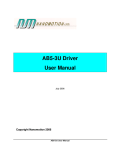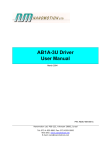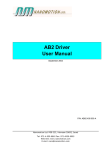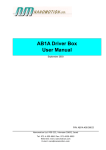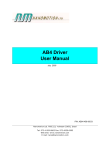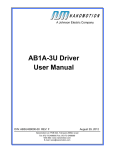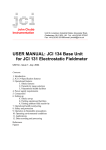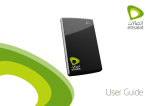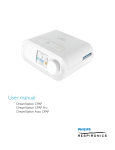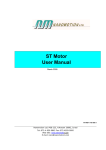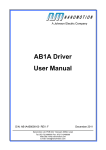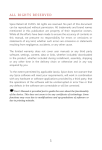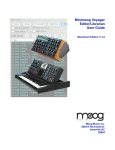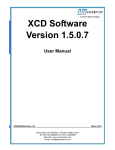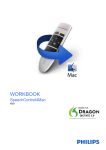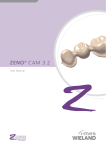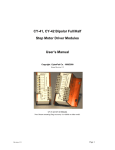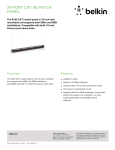Download AB5 Driver User Manual
Transcript
AB5 Driver User Manual June 2005 P/N: AB05 458 200 A Nanomotion Ltd. POB 623, Yokneam 20692, Israel Tel: 972-4-959-0862 Fax: 972-4-959-0995 Web Site: ww w.nanom otion.com E-mail: [email protected] Copyright and Warranty Copyright This document contains proprietary information of Nanomotion Ltd., and Nanomotion Inc., and may not be reproduced in any form without prior written consent from Nanomotion Ltd. and Nanomotion Inc. No part of this document may be reproduced, translated, stored in a retrieval system or transmitted in any form and by any means, electronic, mechanical, photographic, photocopying, recording, or otherwise, without the written permission of Nanomotion Ltd. Information provided in this document is subject to change without notice and does not represent a commitment on the part of Nanomotion Ltd. Copyright February 2004, Yokneam, Israel. All rights reserved. All products and company names are trademarks or registered trademarks of their respective holders. Limited Warranty Nanomotion Ltd. (hereinafter NM) warrants the product (other than software) manufactured by it to be free from defects in material and workmanship for a period of time of one year (except those parts normally considered as consumable/expendable components such as motor conditioning brushes). The warranty commences thirty (30) days from the date of shipment. NM warrants those parts replaced under warranty for a period equal to the remaining warranty coverage of the original part. NM’s sole and exclusive obligation under this warranty provision shall be to repair, or at its sole option exchange defective products or the relevant part or component, but only if: (i) the Purchaser reports the defect to NM in writing and provides a description of the defective product and complete information about the manner of its discovery within ten (10) days of its discovery; (ii) NM has the opportunity to investigate the reported defect and determines that the defect arises from faulty material, parts or workmanship; and (iii) the Purchaser returns the affected product to a location designated by NM. These provisions constitute the exclusive remedy of the Purchaser for product defects or any other claim of liability in connection with the purchase or use of NM products. This warranty policy applies only to NM products purchased directly from NM or from an authorized NM distributor or representative. This warranty shall not apply to (i) products repaired or altered by anyone other than those authorized by NM; (ii) products subjected to negligence, accidents or damage by circumstances beyond NM control; (iii) product subjected to improper operation or maintenance (i.e. operation not in accordance with NM Installation Manuals and/or instructions) or for use other than the original purpose for which the product was designed to be used. NM shall not in any event have obligations or liabilities to the Purchaser or any other party for loss of profits, loss of use or incidental, increased cost of operation or delays in operation, special or consequential damages, whether based on contract, tort (including negligence), strict liability, or any other theory or form of action, even if NM has been advised of the possibility thereof, arising out of or in connection with the manufacture, sale, delivery, use, repair or performance of the NM products. Without limiting the generality of the preceding sentence, NM shall not be liable to the Purchaser for personal injury or property damages. CE C ompliance i CE compliance CE Compliance This product was tested for Electrical Safety and Electromagnetic Compatibility. It conforms with EMC Directive 89/336/EEC, Article 7(1); with FCC 47 CFR part 15 subpart B; and with LV directive 73/23/EC, Article 5 and satisfies the requirements of the following standards: EN 61800-3:1996 + A11: 2000 for second environment. EN 61000-3-2:2000, EN 61000-3-3:1995 + A1: 2001. FCC 47 CFR: 2002 part 15, subpart B. EN 61010 – 1:2001. ii Table of Contents Table of Contents 1 AB5 DESCRIPTION .............................................................................................................1 1.1 General........................................................................................................................1 1.2 Main Features .............................................................................................................1 1.3 Operating Principles Overview....................................................................................2 2 CONNECTIONS AND I/O SETTINGS .................................................................................3 2.1 Front Panel Description...............................................................................................3 2.1.1 Front Panel Connectors..............................................................................................4 2.1.2 Front Panel LED Indicators ........................................................................................4 2.2 Motion Control Interfaces ............................................................................................4 2.2.1 Analog Controller Connection.....................................................................................4 2.2.2 Joystick Connection ....................................................................................................7 2.3 Cable Connections ......................................................................................................8 2.3.1 Grounding the Driver – IMPORTANT !.......................................................................8 2.4 Motor Connections ......................................................................................................8 2.4.1 Motor Cable Length ....................................................................................................9 2.5 Opto-isolated Inputs ....................................................................................................9 2.5.1 Voltage Source Configuration...................................................................................10 2.6 Fault Output...............................................................................................................11 2.7 Before Operating the Motor ......................................................................................11 3 AB5 OPERATION...............................................................................................................12 3.1 Set Offset Procedure.................................................................................................12 3.1.1 Setting the Offset ......................................................................................................12 3.2 Operation Modes.......................................................................................................12 3.2.1 Velocity Mode Operation ..........................................................................................13 3.2.2 Step Mode Operation................................................................................................13 3.2.2.1 3.2.3 3.2.3.1 Enabling the Step Mode ........................................................................................13 Brake On Mode.........................................................................................................13 Enabling the Break_on ..........................................................................................13 4 SPECIFICATIONS ..............................................................................................................14 4.1 Parameters and Conditions ......................................................................................14 4.2 AB5 Layout ................................................................................................................15 4.3 Pin Arrangement .......................................................................................................16 4.4 Envelope Of Performance (EOP) Considerations ....................................................18 iii Lists of Figures and Tables List of Figures Figure 1: AB5 Driver Front Panel ........................................................................................3 Figure 2: Differential Analog Input Connection ...................................................................5 Figure 3: Non-Differential (single-ended) Analog Input Connection...................................6 Figure 4: Joystick Connection .............................................................................................7 Figure 5: Opto-Isolated Input Interface ...............................................................................9 Figure 6: Jumper 3 Configuration......................................................................................10 Figure 9: Mechanical Dimensions .....................................................................................15 Figure 8: EOP Considerations...........................................................................................19 List of Tables Table 1: Electrical Specifications.......................................................................................14 Table 2: Recommended Power Supplies..........................................................................14 Table 3: Physical Properties..............................................................................................14 Table 4: Environmental Conditions ...................................................................................14 Table 5: Analog Input Specifications.................................................................................14 Table 6: Control Terminal Pin Out.....................................................................................16 Table 7: Motor Output Port Pin Out...................................................................................16 Table 8: I/O Port Pin Out ...................................................................................................17 iv List of Abbrevations List of Abbreviations A Ampere AC Alternating Current DC Direct Current LED Light Emitting Diode mA Milliampere mW Milliwatt PWM Pulse Width Modulation TTL Transistor-Transistor Logic Vrms Volts Root Mean Square v AB5 Description 1 AB5 Description 1.1 General The AB5 is a 24V single axis amplifier box for driving Nanomotion Piezo-Ceramic motors, which eliminates the “dead zone” previously associated with Piezo-Ceramic operation. It interfaces between the input command from a controller or joystick to the motor. As a result, it provides the smooth control of a DC motor and the accuracy and stability of a Piezo motor. The AB5 box consists of three cards that convert the input command signal into the output voltage necessary for Nanomotion motors. The Logic and Driver cards are common to all AB5 configurations, while the Personality card is configuration specific and can be replaced when a motor type or number is changed. 1.2 Main Features High precision (11 bits) control of the output power stage Zero Dead Band Drives up to four HR8 motors Four operation modes: Velocity, Step, and Brake On/Off Interface to an analog command Modular design to allow replacement of configuration specific Personality cards. Discrete inputs enabling feedback from external sources, such as, limit switches, emergency stop command, etc. Three color LED indicators Over Current, Over Voltage, and No Load protections Minimized sensitivity to cable length User defined ENABLE input logic. 1 AB5 Description 1.3 Operating Principles Overvie w All piezo-ceramic motors operation principles are based on the inherent friction generated between the motor and the slide. The AB5 driver eliminates this inherent friction between motor and slide, by using a “brake off” principle of operation. In order to better understand the “brake off” let us imagine that we stop an automobile at a traffic light while on an incline. We have two options while waiting for the light to change. Option 1 (other drivers operation principles): Engage gear in neutral and use the break to remain in place. This results in a “dead zone” where no movement occurs until a minimum of pressure on the gas pedal is reached. Option 2 (AB5 operation principle): Remain in gear with an equilibrium of the clutch and gas holding us in place. Even the slightest increase in pressure on the gas pedal combined with a decrease in pressure on the clutch causes the automobile to move. The amount of pressure applied to the clutch and the amount of pressure applied to the gas pedal are the factors that cause the vehicle to move. By letting the motor vibrate in a certain, unique way, the “dead zone” phenomena, associated with the friction of the piezo-ceramic motor is bypassed. It is hence clear that even when zero command voltage is applied, and no motion is generated, the motor is still excited and thus consumes energy and is heated up. The driver’s output at zero command is system dependant and is affected by various factors, including the gravitational pull of an incline or decline, slide friction, vacuum/ non vacuum etc. This output level can be user defined according to the specific system requirements, see section 3.1. 2 Connections and I/O Settings 2 Connections and I/O Settings 2.1 Front Panel Description The AB5 front panel (see Figure 1) contains the following connectors and indicators: Control Terminal Motor Output Port I/O Port Power/Enable Indicators Ground Screw Figure 1: AB5 Driver Front Panel 3 Connections and I/O Settings 2.1.1 Front Panel Connectors Connector Description Control terminal 5 pin connector – Receives +24V from an external source and provides direct control over the motor ENABLE signal and the analog control signal (+Vin and/or -Vin). (Mating connector is by Wieland, p/n 25.621.0553.0) I/O Port 25 pins D-type female connector - Interfaces to the control source (joystick or controller) Motor Out 9 pins D-type male connector -Interfaces to the motor. See also Table 6, Table 7 and Table 8 2.1.2 2.2 Front Panel LED Indicators CONDITION POWER ENABLE Vcc < 4.6V Off Off Vcc > 4.6V; Motor not connected Green Off Motor connected and disabled Green Orange Motor enabled Green Green Over Current / Over Voltage Green Red Motion Control Interfaces The AB5 Driver Box can receive the input signals either from a motion controller or from a joystick. The schematic diagrams of the motion controllers and joystick connections to the AB5 Driver Box are provided in following sections. NOTE: 2.2.1 The motor may be operated with minimum control signals applied to the Control Terminal: +24V,GND, +VIN, -VIN, ENABLE_IN. Analog Controller Connection There are two options of an analog connection of a motion controller to the AB5 Driver Box: Differential connection (see Figure 2) Single-Ended Connection (see Figure 3) The differential connection enhances noise immunity. 4 Connections and I/O Settings AB5 Terminal Block 5 Pin DC Power Supply Controller 1 +24V 2 Gnd Twisted and shielded cable D-Type 25 Pin +Vout 1 Vin + -Vout 14 Vin - Shield Status 3 Fault Enable 24 Enable Gnd 2 Gnd D-Type 9 Pin Motor 3 Up 4 Com 5 Down 1 Gnd 6 Motor_Cnctcd 7 Gnd Figure 2: Differential Analog Input Connection 5 Connections and I/O Settings AB5 Terminal Block 5 Pin 1 +24V DC Power Supply 2 Gnd Twisted and shielded cable Controller D-Type 25 Pin +Vout 1 +Vin -Vout (or Gnd) 14 -Vin 9 Gnd Shield 2 Gnd Status 3 Fault Enable 24 Enable D-Type 9 Pin Motor 3 Up 4 Com 5 Down 1 Gnd 6 Motor_Cnctd 7 Gnd Figure 3: Non-Differential (single-ended) Analog Input Connection. 6 Connections and I/O Settings 2.2.2 Joystick Connection Using the joystick for supplying the command voltage to the AB5 Driver Box allows the user to manually drive the motor without using a motion controller. AB5 Terminal Block 5 Pin 1 +24V DC Power Supply Joystick 2 Gnd Twisted and shielded cable D-Type 25 Pin +10V 23 +10V +Vout 1 +Vin -10V 11 -12V Shield 9 Gnd 14 -Vin 2 24 Gnd Enable D-Type 9 Pin Motor 3 Up 4 Com 5 Down 1 Gnd 6 Motor_Cnctd 7 Gnd Figure 4: Joystick Connection 7 Connections and I/O Settings 2.3 Cable Connections Connect the following groups of cables together, isolating each of the signals: POWER SUPPLIES – use 22 AWG (or lower AWG) wires for the power supplies. For noisy surroundings, it is recommended to twist the ground line and the power line together. ANALOG COMMAND – a twisted shielded cable is recommended. DISCRETE INPUTS – These signals are not sensitive to noise and can be grouped together in the same harness with any of the other groups. 2.3.1 Grounding the Driver – I MPORTANT ! ATTENTION: 2.4 To ensure that minor electric shock does not occur, the ground screw on the bottom left of the front panel MUST be connected to the infrastructure earth. Motor Connections The “Motor Connected” signal is available only at the motor connector, where it is shorted to ground (see Table 7). This ensures that unprotected motor pins will not be exposed to high voltage when the motor is not connected. If more than one motor is connected to the AB5, use a suitable branch cable. If the motor type or the number of motor elements is changed, consult Nanomotion for the appropriate driver configuration changes that may be required. NOTE: The circuit will only close if a motor is connected to each of the branches. The motors will not work if even one of the branches of the cable is not connected to a motor. 8 Connections and I/O Settings 2.4.1 Motor Cable Length The maximum allowed total cable length connecting the AB5 to the motor(s) is 20 meters for the HR types and 10 meters for the ST. Minimum length is 0.5m. Use Nanomotion standard cables. Branching is possible to two and four identical motors. Branch cables must be of identical length, the sum of which not exceeding the allowed total cable length. NOTE: 2.5 Nanomotion can guarantee proper driver and motor performance only when Nanomotion standard cables are used. Opto-isolated Inputs The following inputs are opto-isolated and are activated “low”, i.e by shorting them to ground (see Table 8 for more details): Emergency_Stop. Disables the AB5 output. Enable_Sign_In. Changes Enable_In input logic to active “high”. Enable_In. Enables driver operation; Should be activated before the motor can be run. Step_Mode. Enables Step mode operation Brake_In. Disables the AB5 output. Set_Offset_Level. Adjust zero command level. VCC Jumper 3 1 User Voltage VCC 390Ω To control logic Command Input AB4 Figure 5: Opto-Isolated Input Interface 9 Connections and I/O Settings 2.5.1 Voltage Source Configuration The opto-isolated input signals (2.2.1) are activated as short-to-ground. The voltage for the opto-isolated circuit (see Figure 6) is provided by either the internal +3.3V supply (default state) or an external voltage supply via pin 13 on the I/O Port connector. The input to be activated should be shorted to external voltage supply ground. Configure jumper JP2 on the top AB5 card according to the voltage source: Pin 1 shorted to Pin 2, for an internal +3.3V source (default factory setting) Pin 3 shorted to Pin 4, for an external +3.3V voltage source 3 1 JP2 3 1 JP2 4 2 Connection for Internal source 4 2 Connection for External source Figure 6: Jumper 2 Configuration ATTENTION: Do not short other pins on JP2. Doing so shorts the external power supply to the +3.3V supply! The input circuit is limited to sink up to 10 mA but not less than 3 mA. 10 Connections and I/O Settings 2.6 Fault Output The Fault Output follows open collector logic. When activated (“low”), it disables the driver under the following conditions: Over-current Over voltage Connecting the motor when the power supply is already connected and turned on, may sometimes result in Fault. To avoid this, please first connect the motor and finally the power supply. NOTE: 2.7 The Fault output is capable of sinking a maximum of 20 mA, and is not protected from over current. Before Operating the Motor Before operating the AB5, verify the following: • Jumper JP2 is set to the required mode of operation (see section 2.5.1) • Mechanical screws lock all connectors • The external power supply is capable of supplying the required power consumption of the AB5 (see Table 2) • There is no command when switching the power to “ON” • All motors are correctly mounted. The command should be limited according to the envelope of performance of the motor. Refer to the Motor User Manual. ATTENTION: Driver should be grounded to infrastructure earth before operating. 11 AB5 Operation 3 AB5 Operation 3.1 Set Offset Procedure Set Offset calibrates the “zero command” for each specific motor and system. Each new motor should be calibrated using the Set-Offset procedure before being used. This is necessary to prevent slide movement when the zero command is applied. 3.1.1 3.2 Setting the Offset 1. Toggle Enable off and then on again before starting the adjustment. 2. Apply the zero command and see if there is slide movement. 3. Adjust the command voltage level until the slide movement stops. 4. While still applying the above command level, momentarily short pin 19 to ground. The driver “remembers” this level of command as its zero. (Max 2.5V ) 5. Apply now zero command level and verify that the slide is in standstill. Operation Modes Both Enable_In and Motor_Connected inputs must be active for operation, regardless of the operation mode. The AB5 can be operated in one of the three operation modes listed below. Velocity (AC) Mode, in which the motor is driven continuously. Step Mode, in which the driver output is turned OFF and ON at hardware, predefined intervals, thus driving the motor in discrete steps. Brake On Mode, while in Velocity Mode,enables holding force to be turned ON or OFF, as desired by the user. 12 AB5 Operation 3.2.1 Velocity Mode Operation In this operation mode, the motor is driven continuously by applying the analog command voltage (± 10 V) using a relevant interface device (joystick or motion controller). This is the driver default. 3.2.2 Step Mode Operation In this operation mode, the driver output to the motor is turned on and off for fixed time intervals defined in the hardware as follows: ON phase - 1/16 second OFF phase - 0.5 second The amplitude of the output corresponds to the analog command input value and thus determines the speed of the motor. 3.2.2.1 Enabling the Step Mode Short pin 16 to ground to enable Step mode operation. 3.2.3 Brake On Mode This option is used when the inherent break force of the motor is needed. The driver is disabled and the motor is turned off. (NOTE: although the driver is disabled, there is no reseting, as is the case when disabling is carried by the Emergency Stop or by the Enable_in inputs) 3.2.3.1 Enabling the Break_on Short pin 17 to ground to enable the break. Disconnect it from ground to get the Break_Off. 13 Specifications 4 Specifications 4.1 Parameters and Conditions Table 1: Electrical Specifications Power Input +24 VDC ±5% (stabilized) Power Consumption without Load +24 VDC/200 mA Table 2: Recommended Power Supplies Supply Voltage +24 VDC ±5% Maximum Current Consumption Applicable For 2A E1 to E4 3A E8 6A E16. 12A E32 Table 3: Physical Properties Weight 450g Table 4: Environmental Conditions Operating Temperature 0°C to 50°C Storage Temperature -40°C to 70°C Operating Humidity Up to 80% Non-condensing Table 5: Analog Input Specifications Input voltage range: ±10V Input impedance: 10kΩ Input low pass filter: 2.7 kHz 14 Specifications 4.2 AB5 Layout Figure 7: Mechanical Dimensions 15 Specifications 4.3 Pin Arrangement Table 6: Control Terminal Pin Out Pin Signal Name Function Description 1 +24V Input +24 VDC Power Supply 2 Gnd Ground 3 +Vin Input Analog Command from controller. 4 -Vin Input Analog Command from controller. 5 Enable_In Input Enable. See section 2.5 Table 7: Motor Output Port Pin Out Pin Signal Name Function Description 1 Gnd Power supply ground Safety input; shorted to pin 6 in order to verify the motor connection and to prevent driver operation without the motor. 2 N.C. Not used 3 Motor_Up High voltage output Connected to the white motor terminal. 4 Motor_Common High voltage output Connected to the black motor terminal. 5 Motor_Down High voltage output Connected to the red motor terminal. 6 Motor Connected Input Safety input; shorted to pin 1 in order to verify the motor connection and prevent the driver operation without the motor. 7 Gnd Power supply ground Shorted to the shield 8 N.C. Not used 9 N.C. Not used 16 Specifications Table 8: I/O Port Pin Out Pin Name Function Input Description 1 V_In_Pos 2 Gnd Ground 3 Fault Output 4 Gnd Ground 5 SPI_Select - Disabled 6 Direction - Disabled 7 SPI_Data - Disabled 8 Acs_Int_Mode - Disabled 9 Gnd - Disabled 10 Set_Com_1 - Disabled 11 -10V 12 Emergency_Stop Input Safety shut down See section 2.5 13 User_Voltage Input External power supply for the opto-isolated type inputs 14 V_In_Neg Input 0 to -10VDC Analog control 15 Gnd 16 Step_Mode Input Step mode selection 17 Brake_In Input Disables driver operation (without resetting) 18 SPI_Clock 19 Set_Offset_Level Input Read command and remember as offset. 20 Enable_Sign_In Input When shorted to ground, the Enable_In input is active high. Otherwise, Enable_In is active low 21 NC 22 Set_Com_2 23 +10V 24 Enable_In 25 NC Output 0 to 10VDC Analog control See section 2.6 -10V supply for external device (Joystick) Ground - Output Input Disabled Disabled +10v supply for external device (Joystick) Must be activated to enable driver operation 17 Specifications 4.4 Envelope Of Performance (EOP) Considerations As earlier described (section 1.3), when operating the driver in the Brake Off mode, the motor consumes power at all times, even when the control command voltage is zero, thereby reducing the thermal EOP. Figure 8 on the next page describes the motor velocity-force curves with the allowed operation duty cycle and continued operation. Important: If a Break Off mode is desired while working in vacuum, the following operating regime must be maintained: within the specific duty cycle stated in the chart, once the “maximal continuous operation time” has elapsed, the motor must be disabled and allowed to cool off for at least 400 seconds. For example, looking at curve C, in vacuum, with the break off: after 280 seconds of working at the 45% duty cycle specified, the motor must be disabled for at least 400 seconds to cool off. This is true also if a smaller duty cycle is maintained. 18 Specifications Break Off Break Break On On Figure 8: EOP Considerations 19

























